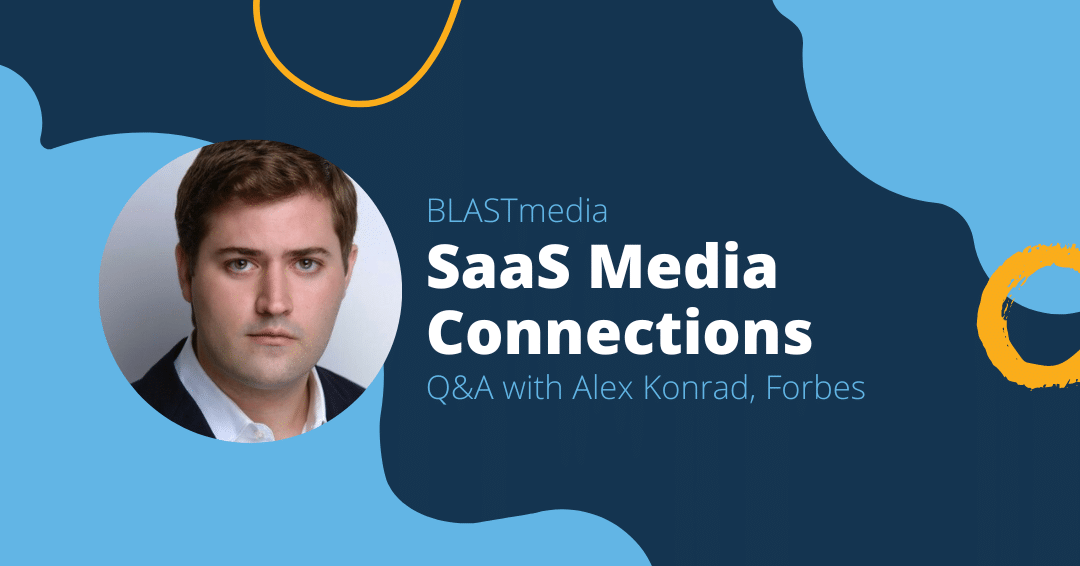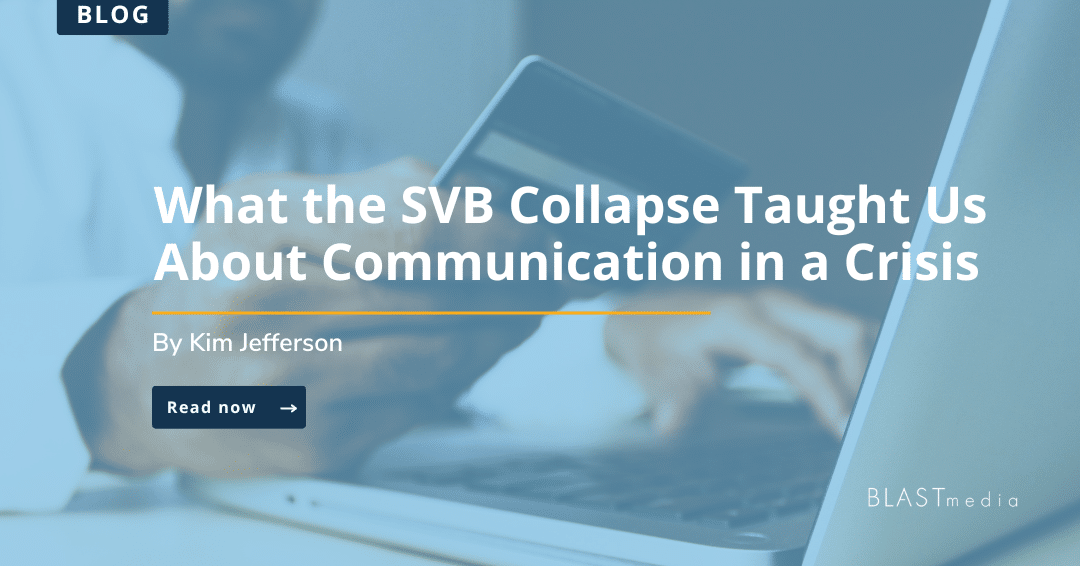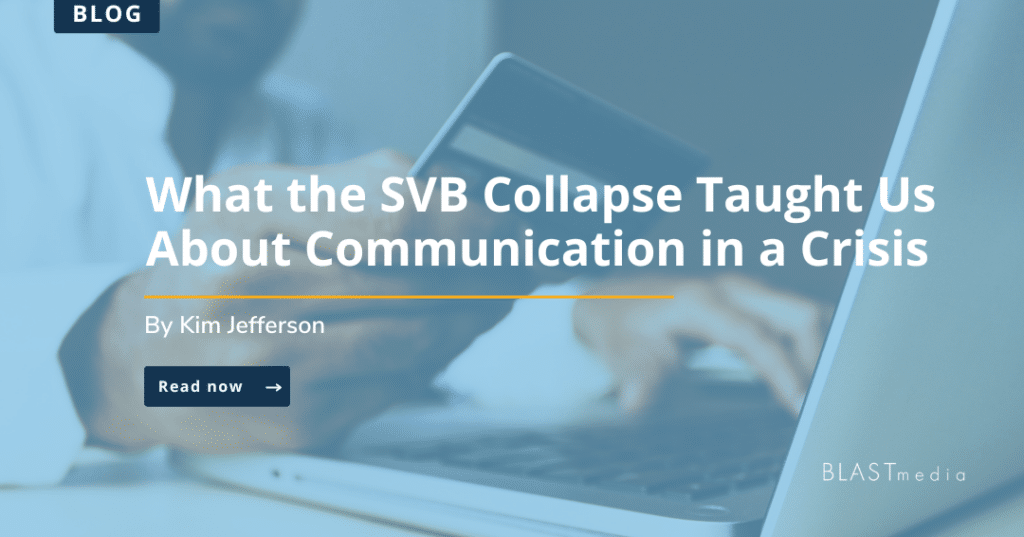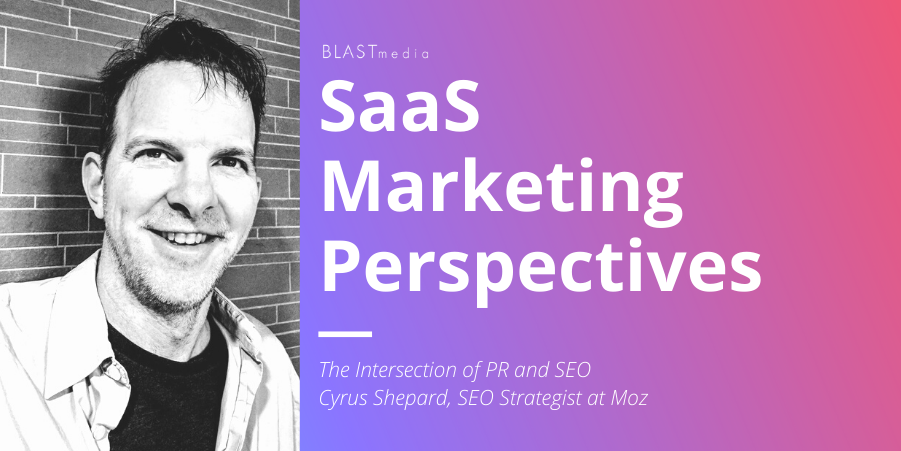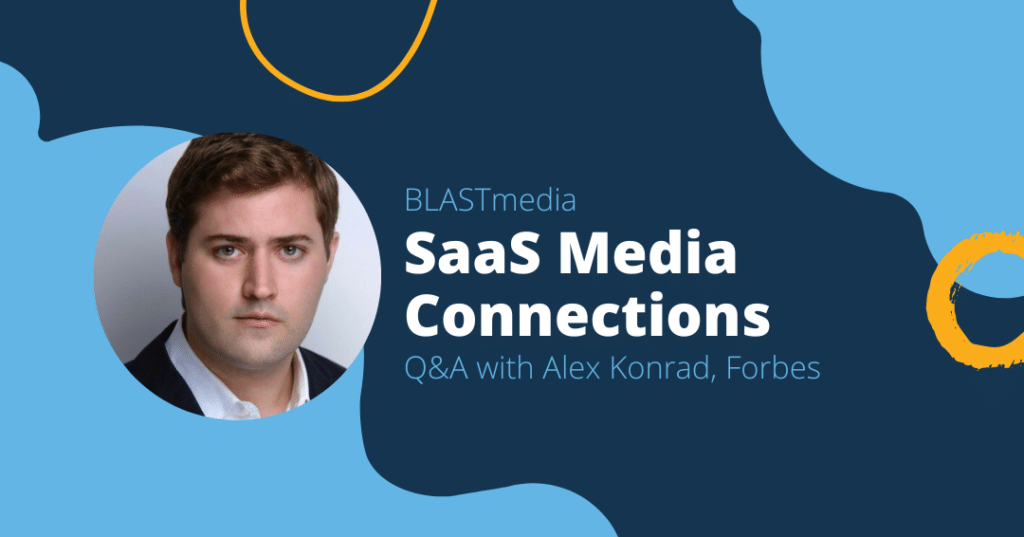
We’re bringing back our media connections series, and we thought what better way to kick us off than with Alex Konrad, senior editor at Forbes. He’s worked at Forbes for 10 years, covering venture capital, cloud and startups. Additionally, he edits the Midas List, Midas List Europe, Cloud 100 list and 30 Under 30 for VC. You might have also caught him in a Hulu documentary 👀
While Alex covers what some consider a ‘sweet spot’ in SaaS, he can’t cover every startup story. We sat down with him to discuss his PR pet peeves, how he comes up with story ideas, and what topics he’s hot about right now.
How do you choose what you write about? What elements make a company interesting to you?
Alex: One important thing to remember is that a good company does not equal a good story. Sometimes the best stories are because companies are not great, and sometimes great companies don’t have a great story. It’s OK not to have a great story yet, but it can be difficult to force it if nothing is interesting or dramatic.
As reporters, we’re looking for a compelling narrative that speaks to a bigger lesson, trend or warning. We must think about each company we look at and consider if it embodies something bigger. What is the exciting narrative? That might be a David vs. Goliath story, overcoming the odds as a founder or someone with a surprise second career or a quirky passion.
A fun story I once wrote was about a midsize tech company at the time called Appian. It’s not the most exciting company in the world, although it did go public, but its CEO is an elite board game designer and has designed and commercialized multiple board games. Every year he goes to the world boardgaming championships. Going with the CEO of a public company to watch him compete and understand his leadership style from his board-game play was the kind of thing any reporter would want to do once. It’s a good example where the story might be more compelling than the business itself.
I noticed crypto and Web3 were common themes in your stories last year. Is that a personal interest, or is that a macro trend that performs well that led to stories written about that?
Alex: Journalists want to write about the hot-button topics of the day because they want to write useful information that people will plausibly read. There are topics that I’d love to spend more time on, but it’s hard to find my angle or justify why people would care about them.
It is a business. We have a lot of autonomy at Forbes, and in some newsrooms, there is a lot of trust in a reporter, but it’s never a good feeling to spend a lot of time on a story that only a few people care about. At Forbes, we’re not judged by our pageviews, but still, if you create something, you want it to matter.
With something like crypto, we at Forbes try to follow the money, especially me as the venture capital editor. If that industry has lost its mind about a topic, I need to have a point of view on it, explore it and look where the money is flowing. It’s not necessarily a great thing, but it’s meaningful, and if you’re a founder, or you work in the tech industry, or you want to learn about it, you need to know what that buzzy topic is on some level.
Are there any other tech trends or technologies that you’re personally interested in right now that you think will be a focus in 2023?
Alex: I am looking at AI, where we recently published a feature explaining the field. I wrote a cover story a couple of years ago on UiPath. I’ve written a lot about work software companies like Slack, Notion, Asana and Canva. The future of work is always exciting, and how generative AI could play a significant disruptive player in many of our workflows is compelling. I’ve enjoyed meeting companies that are trying to build on top of these tools.
Climate is something my team is interested in. There is more appetite from investors to put money into climate startups again. There is a bit of a sense of urgency by some people in the industry that now is the time to work on solutions there, but at the same time, climate companies face a high bar for success: they’re capital intensive, and historically we haven’t had that massive breakout climate tech company. So we might be cautious about not overhyping or over-promising.
I continue to write a lot about representation. We love looking at underrepresented founders doing great things or companies coming from unexpected places. Our 30 under 30 summits have spent the last few years in Detroit, and now it will be in Cleveland. We love at Forbes to try and break out of the bubble of Silicon Valley and New York.
Are there any other hot spots you’re seeing companies come out of that you’re interested in?
Alex: I think Seattle will become more relevant in the future, especially with this passion for AI. They have the Allen Institute and smart folks coming out of the big tech companies.
I’ve spent a lot of time understanding the European market. I haven’t done all the homework, but all the signals point to Paris being a surprisingly great place for entrepreneurship. I’m open to looking at other areas that are outside the so-called west of Europe and the U.S. as well.
What is the best channel and time to pitch you?
Alex: Emailing me politely during work hours is the best chance of success. I don’t appreciate when people try to gain creativity points by reaching people in unusual methods like my personal social media accounts. I don’t like cold calls because my day is usually chaotic. If I’m getting a call from an unknown number, I’m only answering it because it might be a source on a story, and for it to be a non-super time-sensitive pitch or hail mary pitch is inefficient for me.
I have a lot of empathy for PR professionals, but there are a lot more PR people than journalists. It’s hard for me to feel we owe a response on every pitch. I can spend a whole day just responding, and I still wouldn’t get to every pitch in my inbox. That said, I try to respond to exclusive offers because I know the person is waiting for my response before going to someone else. I will be very unlikely to respond to something that misrepresents anything. For example, we recently had an exclusive offer sent to my entire team. That’s not going to make us feel good that we all got the same email, so that will put them on the untrustworthy list.
Otherwise, emailing me a general pitch and sending a follow-up email is reasonable, but I will not have time to respond if I haven’t responded to one follow-up. Unfortunately, sending three more messages doesn’t make anyone happier.
I know that’s difficult because I know some clients want PR professionals to have a hard answer, but I would encourage my friends in PR to be that go-between for the journalists and the client and feel empowered to speak on behalf of the journalists and say, “It’s a pass from Alex, calling him isn’t going to improve the situation. We should graciously move on.” There have been times when I’ve been hounded to get a hard no, and it’s not helping anyone. The goal for a pitch should not be just to get a hard no.
What are other pitch pet peeves?
Alex: The relationships I value the most with PR professionals are the ones where they can guess how I think and act as a go-between between a client and me on an idea. They can anticipate when something won’t be a good fit or, at most, ask whether I think this will be a fit for someone else on my team.
One other pet peeve is if I go out of my way to pass on something or explain why something isn’t going to be a fit, an unfortunate number of times the person feels like they’re in the middle of a live conversation with me and can bring up something else. Given asynchronous communication, that is not the case. Now you’ve sent me another email, and you expect another response. What it’s doing is training me not to respond because if I politely pass, you’re going to pitch another client, and it’ll take more time out of my day to help you.
The last thing I’ll close on is conveying that the best relationships are back and forth. Some folks have brought me great stories in the past or tips, and then it does feel more like a back-and-forth. Other people feel like we’re old friends because they’ve pitched me for years unsuccessfully, and I’ve tried to be polite back, but we’ve never met. They’ve never actually helped my career, so the idea that we’re some partnership is misguided. I’ve helped them by passing or doing whatever to check a box, but no box on my end has ever been checked off.
That’s something to remember: unless we’re writing a big exciting story, agreeing to meet is not a win for us. What comes out of the meeting can be a win. Just the act of going to a meeting puts us in the red. We’ve invested time in this that we could have used elsewhere, and we need to deliver on that eventually. Earlier in my career, I agreed to a million meetings. I didn’t do a good job of converting those meetings into conversation-starting stories, so now I am more thoughtful about why the meeting would be helpful.
Do you have a list of go-to sources that you reach out to? How did those people build that relationship with you?
Alex: Companies and people who punch above their weight or are willing to give us a perspective that isn’t the known public perspective are ones that I will remember, and I am more likely to trust them generally in the future.
Let’s say we’re looking at AI, and we’re talking to all these huge companies. A small startup says, “You may not want to write about my small AI startup today, but I used to work at Google, and I can tell you pretty confidently the behind-the-scenes of how Google is approaching this.” OK, so maybe you’re a source on Google’s AI perspective, and then as your company gets bigger, I’m more likely to think of you and know you’re legit and potentially cover you down the road. But you have to give me something to trust you when you want something.
People think that meeting has built a relationship, but the journalists want something to come out of that relationship. My best go-to’s are people who are sources. They tip me on things. I’m writing a story about X. Do they know anyone with inside info about that topic? They’ll say yes or no, honestly. They won’t try to shoehorn a client in. There are a few people in my head, whether VCs, founders or PR professionals, who are good at understanding that flow, so I go to them first.
Are there other things that make a pitch stand out to you?
Alex: I’m looking to be surprised. I’m looking for something contrarian or that teaches me something that will get my attention. Any facts that speak to that compelling, personal story might be interesting to me, or any breadcrumbs that can allow me to think that this speaks to a bigger story. If a pitch was basically like:
Hey, we’re a climate tech company, and we’re doing this alternative to carbon capture. It’s very early, but we worked at the leading carbon capture startup, and we got disillusioned that it’s not effective.
Communicating that in some way might interest me because it’s a two-for-one. I can learn what you’re doing, but I’m also interested in why carbon capture is not working. They can punch above their weight. That’s something we look for.
So, a founder’s background is a defining factor?
Alex: It’s helpful if they’re compelling. If they’re not relevant, then you need to try something else. The more companies can be evaluated beyond just how much they’ve raised, who their backers are, and what scale they’re at is going to be important. The reality is few companies will pitch us, hey, you’ve never heard of us, and we have $100M in revenue — and if they do, they’re often 30-year-old private equity-owned companies that will not excite our readers either.
Can you give us an overview of your editorial process?
Alex: It’s very different based on the type of story. If it’s a quicker, exclusive story, I can call the shots on whether or not it makes sense, and then I get approval from my editors. Forbes trusts its reporters a lot to know their beats and understand what’s story-worthy.
Once you get into stories requiring travel or more time, there will be more dialogue between the reporter or several reporters and our editors. John Paczkowski leads our tech team. He used to run the tech and business reporting at BuzzFeed News, and before that, he was at Re/code with Kara Swisher and that whole crew. He’s very smart and plugged in, so as the story gets more ambitious, I’m more likely to be dialoguing with him. We also have a deputy editor under him, Katharine Schwab, who might be editing our stories and who works closely with John. Typically, I tell them I’m planning to write this online story, and I’ll need an edit. And if I’m saying I want to fly to Europe and meet every company in Paris, that would require a much larger conversation!
Do you have a monthly or quarterly story quota?
Alex: We do not have any hard quotas at Forbes. As a best practice, my team aspires to write at least once a week. We want to put points on the board and don’t want any pent-up pressure that we feel we haven’t published in a while. We also want to stay in the conversation with our sources and the topics we care about.
Publishing a story is the best way to get more people on that topic to reach out to you. That is our goal. It can often not be the case. Leading into the holidays, I got married and went on my honeymoon, and I went two months without publishing a story; this week, I plan to publish three stories. So it can vary.
Forbes likes to think of itself more on the once-a-week cadence, which is very different from the daily places or multiple times-a-day places. It’s also very different from the New Yorker, where you show up every three months, I assume, with a 30,000-word magnum opus. Our stories never get longer than 3,000 words, so it’s a bit different.
Where do you find the idea for most of your stories?
Alex: Most of my stories are not pitch driven. Often the pitch-driven stories come from an existing relationship. For example, a VC I’ve met before with an underrepresented background has a new fund. As they talk about their announcement plan with their PR representatives, they say, “I know Alex at Forbes; let’s see if he’s interested.” It’s a warm intro-type situation where I’ll give real feedback.
It may occasionally be the exclusive offer, or it may be that I come back a year or three months after a meeting and say, “I want to write about this company now.” That’s what happens with the bigger stories. For example, take the cover story I wrote on Flexport. I met with the CEO five years before that. I think I had a catch-up a year before the story that came from an inbound from their agency. A year later, that holiday season, the supply chain was top of mind, and I knew I could reach out to that agency and say the time is right to spend more time with him. They were very helpful in making that happen.


